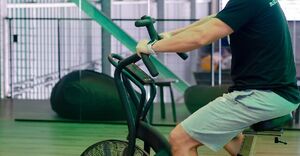
Recovery Ride: Using Exercise Bikes for Rehabilitation and Injury Prevention
Recovery rides are a crucial component of rehabilitation and injury prevention, with exercise bikes playing a key role in this process.
Exercise bikes offer numerous benefits, aiding in the treatment of injuries and being incorporated into rehabilitation programs.
We will explore the benefits, proper usage, precautions, and alternatives to exercise bikes for recovery, emphasizing their importance in recovery and injury prevention.
What Is a Recovery Ride?
A Recovery Ride is a crucial component of the recovery process, involving a low-impact cycling session that aids in muscle recovery and overall physical conditioning.
These rides are typically performed at a moderate intensity, allowing the body to flush out metabolic waste products and reduce muscle soreness post intense workouts.
By maintaining a steady pace and focusing on proper form, riders can promote blood flow to fatigued muscles, facilitating the repair and rejuvenation process.
Integrating Recovery Rides into a weekly training schedule can enhance performance by preventing overtraining and ensuring adequate rest between high-intensity sessions.
How Do Exercise Bikes Aid in Rehabilitation and Injury Prevention?
Exercise bikes play a vital role in both rehabilitation and injury prevention, serving as effective tools in physical therapy programs to enhance muscle strength and promote overall recovery.
These versatile fitness machines offer a low-impact workout, making them ideal for individuals recovering from various injuries or surgeries. By engaging different muscle groups, exercise bikes help in rebuilding strength and improving flexibility, crucial components of the rehabilitation process. The controlled environment provided by stationary bikes allows therapists to monitor and adjust resistance levels to suit each patient’s needs, ensuring a safe and customized workout. Regular use of exercise bikes not only aids in physical recovery but also contributes to mental well-being by boosting mood and reducing stress levels.
What Are the Benefits of Using Exercise Bikes for Recovery?
Utilizing exercise bikes for recovery offers numerous benefits such as aiding in the muscle rehabilitation process, improving cardiovascular health, and allowing for consistent workout frequency.
The use of exercise bikes in recovery routines can be particularly beneficial for individuals looking to enhance their overall muscle strength and endurance. By engaging in low-impact cycling on these bikes, individuals can not only target specific muscle groups for rehabilitation but also build up their cardiovascular fitness levels. Consistent use of exercise bikes fosters a routine that promotes discipline and dedication to one’s fitness goals, which is essential for sustaining long-term health benefits. Incorporating regular cycling sessions into a recovery plan can significantly improve both physical and mental well-being.
What Types of Injuries Can Be Treated with Exercise Bikes?
Exercise bikes can effectively aid in the treatment of various injuries, particularly in facilitating injury management, improving joint mobility, and expediting the overall injury recovery process.
For individuals dealing with knee injuries, the low-impact nature of cycling on an exercise bike can be especially beneficial. It helps strengthen the muscles around the knee joint while minimizing stress on the injured area, promoting faster rehabilitation.
Similarly, those recovering from ankle sprains can use the controlled movement of a stationary bike to regain mobility and range of motion in the affected joint.
In cases of lower back injuries, the seated position on the bike can offer support while engaging the core muscles, contributing to better spinal stability and pain relief.
What Types of Rehabilitation Programs Can Incorporate Exercise Bikes?
Various rehabilitation programs can integrate exercise bikes, utilizing cycling therapy to enhance physical conditioning and achieve specific workout goals tailored to individual recovery needs.
This approach not only helps individuals in their recovery journey but also ensures that their fitness levels are gradually improved in a safe and controlled manner. By incorporating exercise bikes into rehabilitation programs, participants can experience a holistic approach to physical therapy that combines cardio workouts with targeted muscle strengthening. Cycling therapy provides a low-impact way to build strength and endurance, making it an ideal choice for those looking to improve their overall fitness and mobility post-injury or surgery.
How to Properly Use an Exercise Bike for Recovery?
Properly using an exercise bike for recovery involves implementing specific techniques to optimize muscle activation, following a structured exercise program tailored to individual recovery needs.
- Engaging in muscle activation techniques while using an exercise bike is essential for promoting blood flow and reducing stiffness in the muscles. It is crucial to maintain proper form and posture throughout your workout to prevent injury and maximize the effectiveness of each session.
- By incorporating a customized exercise program that targets specific areas of the body needing recovery, individuals can enhance their overall rehabilitation process and accelerate healing. Consistency and patience are key when integrating these recovery techniques into one’s exercise routine, ensuring gradual progress and long-term benefits.
What Is the Recommended Duration and Intensity for a Recovery Ride?
The recommended duration and intensity for a Recovery Ride should be based on individual fitness levels and goals, ensuring a balanced workout session that enhances muscle endurance and supports the recovery process.
Tailoring the duration and intensity of a Recovery Ride to suit specific fitness levels is crucial for optimizing the benefits of the workout. By customizing the ride to match one’s physical capabilities, it ensures that the muscles are adequately challenged without being overstressed. Striking the right balance between intensity and duration helps in fostering muscle endurance, aiding in the overall fitness progression. This approach not only prevents burnout but also promotes steady improvement in performance over time, aligning with the long-term goals of building stamina and strength.
What Are Some Tips for Proper Form and Technique on an Exercise Bike?
Maintaining proper form and technique on an exercise bike is essential for promoting joint stability, maximizing the benefits of physical exercise, and reducing the risk of injuries through effective injury prevention techniques.
One key tip to ensure joint stability is to maintain a neutral spine posture throughout your ride. Keeping your back straight, shoulders relaxed, and core engaged will not only protect your spine but also help in distributing the workload evenly across your body.
Avoid locking your knees during pedaling to prevent unnecessary strain on your joints. Remember to adjust the seat height to a level where your knees maintain a slight bend at the bottom of each pedal stroke, ensuring proper alignment and reducing the risk of knee injuries.
What Are Some Precautions to Take When Using an Exercise Bike for Recovery?
When using an exercise bike for recovery, it’s crucial to observe precautionary measures to prevent injuries, promote joint health, and optimize recovery outcomes based on individual progress.
Maintaining correct posture while cycling on the exercise bike is essential to prevent strain on your joints and muscles. It’s important to adjust the seat height and handlebar position to ensure proper alignment and reduce the risk of injury.
Tracking your progress by monitoring metrics such as distance covered, resistance levels, and heart rate can help you gauge improvements in your recovery journey.
By combining these guidelines with a well-rounded injury prevention program, you can make the most out of your exercise bike routine for optimal joint health and recovery outcomes.
What Pre-existing Conditions May Make Using an Exercise Bike Risky for Recovery?
Certain pre-existing conditions may pose risks when using an exercise bike for recovery, warranting attention to exercise duration, monitoring muscle function, and implementing necessary workout modifications for safety and effectiveness.
Monitoring muscle function is vital to ensure that the individual’s muscles, especially those affected by conditions like arthritis or muscular dystrophy, are not strained beyond their capacity.
By assessing muscle strength and endurance regularly, healthcare professionals can determine the appropriate intensity levels for the exercise regimen.
In cases where modifications are required, adjustments can be made to the resistance levels, seat position, or even the duration of the workout to accommodate the individual’s specific needs and limitations.
How Can You Monitor Progress and Adjust the Recovery Ride as Needed?
Monitoring progress during a recovery ride is essential for tracking improvements, adhering to a consistent workout schedule, applying injury prevention recommendations, and setting realistic goals within a defined recovery timeline.
By regularly assessing performance metrics such as heart rate variability, power output, and perceived exertion levels, individuals can gauge their progress and make necessary adjustments to optimize their recovery rides. Implementing structured recovery sessions tailored to individual needs plays a crucial role in promoting physical well-being and preventing potential injuries. Aligning recovery goals with a specific timeline provides a sense of direction and motivation, ensuring that each session contributes effectively to the overall rehabilitation process.
Are There Any Alternatives to Exercise Bikes for Recovery?
In addition to exercise bikes, there are alternative low-impact exercises that can enhance muscle endurance, support physical recovery, and introduce workout variations to maintain interest and effectiveness in recovery programs.
- Swimming is a great option for individuals seeking to build muscle endurance and promote physical recovery without causing strain on the joints.
- Adding resistance bands to traditional exercises like squats and lunges can also help improve muscle endurance and prevent plateauing.
- High-intensity interval training (HIIT) sessions offer a challenging yet low-impact way to vary workouts and see continuous progress in recovery programs.
- Incorporating yoga or Pilates into your routine can enhance flexibility, core strength, and overall physical well-being, diversifying your exercise regimen and reducing the risk of overuse injuries.
What Are Some Low-Impact Exercises That Can Aid in Rehabilitation and Injury Prevention?
Engaging in low-impact exercises such as swimming, yoga, or walking can significantly contribute to rehabilitation efforts, enhance joint rehabilitation, boost physical performance, and allow for necessary exercise adjustments based on individual needs.
These exercises not only provide a gentle way to improve flexibility and strengthen muscles around the joints but also help in reducing pain and inflammation.
Activities like Tai Chi can aid in balance stability and coordination, crucial for those recovering from joint injuries or surgeries.
Cycling and using elliptical machines are excellent options to increase cardiovascular endurance without subjecting the joints to high impact.
These exercises can be easily modified to suit various fitness levels and accommodate any restrictions or limitations.
How Can You Incorporate Strength Training into a Recovery Program?
Integrating strength training into a recovery program can be advantageous for achieving specific workout goals, utilizing appropriate fitness equipment, and aligning fitness objectives with recovery goals to enhance overall physical well-being.
By incorporating strength training exercises like squats, deadlifts, and bench presses into the post-workout recovery routine, individuals can effectively target different muscle groups while promoting muscle recovery and growth. Utilizing equipment such as resistance bands, dumbbells, and kettlebells can add variety to the strength training regimen and help in achieving a well-rounded fitness routine.
Setting clear fitness objectives that complement recovery goals, such as increasing muscle mass or improving muscular endurance, can provide a roadmap for progress and motivation in the fitness journey.




No Comments